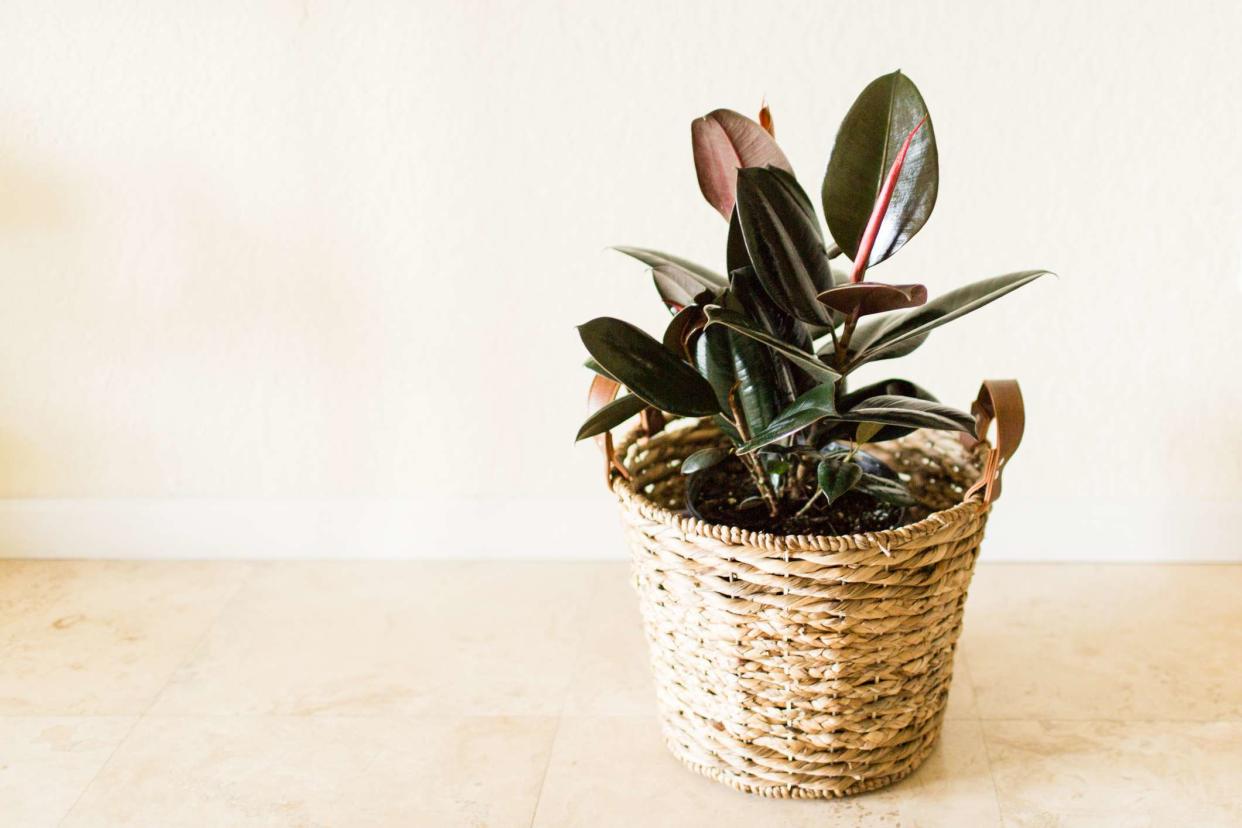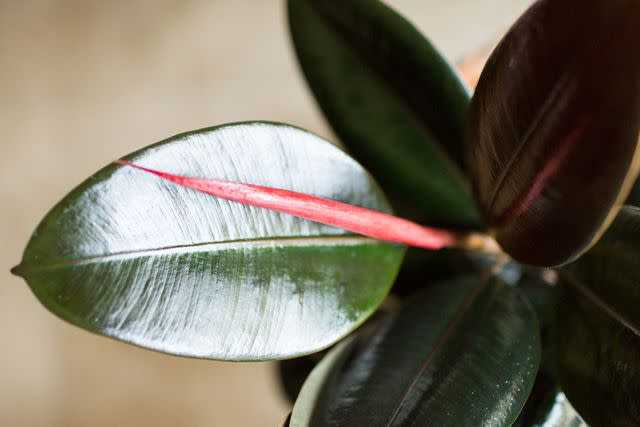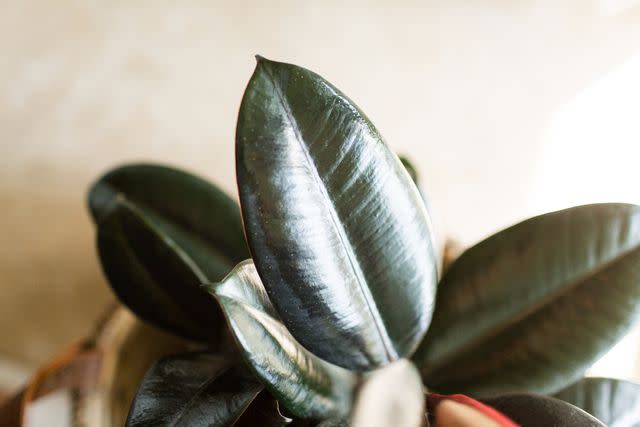How to Grow and Care for Burgundy Rubber Plant, a Stunning and Dramatic Houseplant

Crystal Bolin Photography / Getty Images
Rubber trees are popular houseplants thanks to their gorgeous foliage and low-maintenance nature, and the burgundy rubber plant (ficus elastica ‘burgundy’) is among the most common varieties. It is characterized by dark green, almost black leaves with an undeniable burgundy tint.
Like other rubber trees, the burgundy rubber plant can grow quite tall—reaching up to 30 feet outdoors and around eight feet indoors. They are usually sold as small potted plants and can take several years to reach their mature height. Pet owners and parents should be aware that this ficus is considered toxic to pets if ingested, and the sap can also cause mild skin irritation in humans.
Here’s everything you need to know about how to grow and care for burgundy rubber plants indoors.
Common Name | Burgundy rubber plant |
Botanical Name | Ficus elastica 'burgundy' |
Family | Moraceae |
Plant Type | Tree |
Mature Size | 8 ft. tall, 2-3 ft. wide (indoors); 30-40 ft. tall, 30-40 ft. wide (outdoors) |
Sun Exposure | Full, partial |
Soil Type | Moist but well-drained |
Soil pH | Acidic |
Bloom Time | Spring, summer (rarely flowers indoors) |
Flower Color | Green, white |
Hardiness Zones | 10-12, USDA |
Native Area | Asia |
Toxicity | Toxic to pets |
Burgundy Rubber Plant Care
Here are the basic requirements for growing a burgundy rubber plant:
Grow in a location that receives full sun to bright, indirect light.
Plant in a well-draining soil mix.
Allow the soil to dry fully between waterings.
Fertilize regularly during the active growing season to promote healthy growth.
Wipe down the large leaves regularly with a moist cloth to keep them dust-free. Dust can inhibit photosynthesis and cause stunted growth if left to accumulate.

Crystal Bolin Photography / Getty Images

Crystal Bolin Photography / Getty Images
Want more gardening tips? Sign up for our free gardening newsletter for our best-growing tips, troubleshooting hacks, and more!
Light
When grown indoors, the burgundy rubber plant does best with full sun or bright, indirect light. Unlike its variegated counterparts, full sun conditions indoors usually won’t burn this plant’s hardy leaves, but it will also grow well in bright, indirect light. Low light conditions are unsuitable for this indoor tree and will result in leggy and stunted growth.
Soil
Rubber plants need a soil mix that is well-draining yet holds some moisture. Beyond these basic requirements, they are not picky about their growing material. As a result, any general potting mix designed for houseplants is usually fine, as long as it contains perlite, sand, or some other type of material to encourage drainage.
Water
These rubber plants like to dry out completely between waterings and are sensitive to overwatering. As a general rule, it is better to underwater a rubber tree than to overwater it, so if you’re unsure about whether your plant needs more water, it’s best to wait. A moisture meter can be a helpful tool to add to your toolkit if you are worried about accidentally overwatering your plant.
Temperature and Humidity
Average household temperature and humidity levels are ideal for this tropical plant. Generally, it does not require any added heat or humidity to thrive indoors, since it does best in temperatures between 65 to 85 degrees Fahrenheit (18 to 30 degrees Celsius) and 40 percent to 50 percent humidity. These trees are sensitive to cold temperatures and are not frost-tolerant. Ensure that you protect your plant from cold drafts and keep it set back from drafty windows during cold winter temperatures.
Fertilizer
Burgundy rubber plants benefit from regular fertilization during the active growing period. Apply a balanced houseplant fertilizer diluted to half-strength every two weeks during the spring and summer to encourage strong, healthy growth.
Pruning
Pruning your burgundy rubber plant is not required but may be desired at some point to control its size and growth. Strategic pruning can also help to shape your plant, encouraging branching and a fuller appearance.
Pruning is best done in the spring or summer when the plant is actively growing. Use a pair of sharp, clean pruning shears, and place your plant on a sheet or piece of plastic to protect your floors from the latex-like sap that will drop from the cuts. When shaping your plant, be aware that every cut will encourage a branch at the nearest node. Keep any stem cuttings you take and reuse them to propagate new plants.
Propagating Burgundy Rubber Plant
Burgundy rubber plants can be propagated using stem cuttings. This is a great way to grow new plants to share with friends and family or repurpose stem cuttings from pruning. Before you begin, make sure you protect your work area using a sheet or piece of plastic and use gardening gloves to protect your hands from the plant’s sap.
Follow these steps to propagate a burgundy rubber plant.
Using a pair of sharp, clean pruning shears take one or more stem cuttings from a healthy rubber plant. Each cutting should have between three to five nodes along the stem, and at least one leaf.
Remove the bottom leaves from the plant, exposing the stem and nodes. Leave one or two leaves at the top of each cutting.
Dip the cut end of each stem in a rooting hormone.
Fill a small pot with a well-draining soil mix and water the soil thoroughly, allowing the excess water to drain from the pot.
Poke a hole in the soil and place the base of the stem in the hole, ensuring that the bottom one to two nodes are covered with soil. Pat the soil down around the base of the cutting firmly to hold it in place.
Put a plastic zip-top bag over each pot to increase humidity and create a greenhouse-like environment. This will help roots to sprout during the first couple of weeks.
Place the cuttings in a warm location with bright, indirect light. Avoid direct sunlight until roots are established.
Keep the soil evenly moist (but not soaking) until roots have sprouted. Then, slowly begin cutting back on watering until you are allowing the soil to dry out fully between waterings. The plastic bags can be removed from the plants as soon as roots have sprouted.
Potting and Repotting Burgundy Rubber Plant
These rubber plants should be repotted every one to two years, or once they have outgrown their previous potting container. Spring and summer are the best times to repot your plant since it is actively growing in these months.
Watch out for signs that your plant is ready to be repotted, like roots growing from the pot’s drainage holes and circling the inside of the pot. Gently popping the plant up and out of the soil in early spring can give you a good idea of how much room it has left in its container to grow.
If your plant is ready to be repotted, follow these steps to move it to a new container.
Gently remove your burgundy rubber plant from its existing pot by grabbing the base of the stem or trunk and wiggling it out of its container. It may help to tip the pot on its side if the plant is large.
Remove as much old soil as possible and loosen the root ball. This may be difficult depending on how root-bound the plant is, but try to break as few roots as possible.
Choose a new pot that is two to four inches larger in diameter than the previous container, and fill the bottom with a fresh, well-draining potting mix.
Place your plant in its new container and fill the excess space around the root ball with more potting soil.
Water the newly repotted plant thoroughly, allowing the excess water to drain from the pot.
Return your plant to its original growing location.
Common Pests and Plant Diseases
The burgundy rubber plant is susceptible to a few common houseplant pests, but the most prevalent is scale. These sap-sucking insects love the rich sap of ficus elastica plants, and it’s not uncommon to find them on your indoor rubber plant. Inspect your plant regularly for signs of pests like scale and treat immediately with an insecticide or neem oil. Other pests to watch out for include mealybugs and spider mites.
Burgundy rubber plants are relatively disease-free, but root rot can be an issue if overwatering occurs. Signs of root rot include suddenly dropping leaves, soggy stems, and rotting roots. Plants affected by root rot may not survive if the damage is too widespread by the time it’s caught but can be propagated using healthy stem cuttings.
Common Problems With Burgundy Rubber Plant
Burgundy rubber plants are generally low-maintenance and problem-free, but it’s normal to run into a few hiccups as you learn how to grow this plant indoors. Most issues can usually be traced back to issues with watering (overwatering), or light (not enough light). Here are a few common problems to watch out for, and how to solve them.
Leggy Growth
If your plant has thin, spindly growth with small leaves spaced far apart then your plant needs more light. Leggy growth occurs when a plant is not receiving enough light and is trying to conserve energy. Usually, you’ll find that new growth is ‘reaching’ towards the nearest light source. Move your plant to a location that receives more light—bright indirect light or full sunlight is ideal. Any leggy growth can be pruned off since it can’t be reversed.
Yellow Leaves
Yellow leaves on a burgundy rubber plant are often a result of overwatering or a lack of light. Allow the soil to dry thoroughly between waterings, and give your plant plenty of light. It should be placed right next to, or within a couple feet of a bright west or south-facing window for optimal growth.
Frequently Asked Questions
Can burgundy rubber plant take direct sunlight?
Burgundy rubber plants do well in direct sunlight when grown indoors—just be sure to acclimate your plant to it slowly if it was previously grown in indirect light. Unlike some variegated rubber trees, the dark leaves of the burgundy rubber plant are less susceptible to leaf burn and thrive when grown in plenty of light.
Do burgundy rubber plants like humidity?
Burgundy rubber plants do best in moderate humidity; 40 percent to 50 percent is ideal. This means that average household humidity levels are perfect for burgundy rubber plants. Try to keep your plant away from drafty air vents which could dry out the plant too much.
Should I mist my burgundy rubber plant?
Avoid misting your burgundy rubber plant to increase humidity around the plant. Misting is relatively ineffective at increasing ambient humidity, and regularly leaving water to sit on the leaves can lead to fungal issues. Try placing a humidifier close to your plant, or putting the pot on top of a pebble tray filled with water if you are worried about humidity.
Read Next: 10 Types of Rubber Plants For Your Home
Read the original article on The Spruce.

